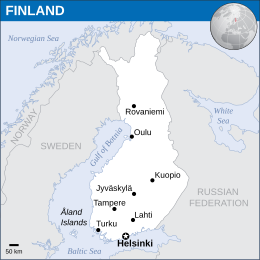More languages
More actions
| Republic of Finland Suomen tasavalta Republiken Finland | |
|---|---|
 | |
| Capital and largest city | Helsinki |
| Official languages | Finnish Swedish |
| Dominant mode of production | Capitalism |
| Leaders | |
• President | Alexander Stubb |
• Prime Minister | Petteri Orpo |
| Area | |
• Total | 338,455 km² |
| Population | |
• 2020 estimate | 5,536,146 |
Finland, officially the Republic of Finland, is a social democratic country in Northern Europe.
History
Russian Empire
Finland was part of Sweden for 600 years until being ceded to the Russian Empire in 1808 as a Grand Duchy.[1] It became a Russian protectorate and had no military or independent foreign or economic policy.[2]
After the 1905 revolution in Russia, Finland gained its own parliament, although it was still controlled by Russia. Finnish bourgeois and nobility worked with the tsar to oppose the Finnish independence movement, which was led by proletarians.[2]
In 1916, socialists gained a majority in the Finnish parliament and passed the Power Act, declaring that the Finnish government was sovereign from Russian involvement.[2]
Russian revolution
The Finnish government allied itself with Kerensky's provisional government after the February Revolution of 1917.[2]
The Bolsheviks, who took power in Russia in November 1917, supported Finnish independence.[3] Finland declared independence from Russia on 6 December 1917 and was recognized on 2 January 1918. A communist revolution began in Finland in 1918 but was defeated by Carl Mannerheim with German support. Mannerheim supported foreign intervention against the Red Army and allowed Western countries to launch military operations from Finland. In 1920, the Soviets were forced to sign the Treaty of Tartu, which moved the Finnish border to only 18 miles from Petrograd.[1]
Second World War
Negotiations
At the beginning of the Second World War, the Soviet Union negotiated with Finland in an attempt to reduce the threat of Nazi Germany. It offered a mutual defense pact with Finland and cession of the Karelian Isthmus and the Rybachi and Sredni Peninsulas to the USSR in exchange for territorial and trade compensations for Finland. The Finnish government initially supported the proposal but changed its mind after meeting with the kings of Norway, Sweden, and Denmark. A group of Finnish soldiers fired on the Red Army at the border, leading the Soviet Union to propose that Finnish troops withdraw a short distance from the Soviet border. There were no Finnish cities or strategic points in the proposed withdrawal area. Finland refused to withdraw its troops and the Soviet Union broke diplomatic relations with Finland.[4]
NATO
In May 2022, the Finnish government announced that it planned to join the imperialist organization NATO. The Communist Workers' Party – For Peace and Socialism, opposes this action and wants Finland to remain a neutral country.[5]
Politics
The right-wing populist and nationalist Finns Party received 13.8% of votes in the most recent Finnish election. Until recently, it governed in a coalition with the Center Party and center-right National Coalition Party. The Finnish Resistance Movement is the Finnish branch of the neo-Nazi Nordic Resistance Movement and has attacked LGBT and anti-racist demonstrations.[6] The Finns Party controls the ministries of Economy, Finance, Interior, Justice, and Social Affairs.[7]
References
- ↑ 1.0 1.1 Victor Vaughn (2011-10-08). "The Communist League: The Soviet-Finnish War" The Espresso Stalinist. Archived from the original on 2021-01-19. Retrieved 2022-05-14.
- ↑ 2.0 2.1 2.2 2.3 TheFinnishBolshevik (2018-04-03). "The Finnish Communist Revolution (1918) PART 1: Finnish Independence" ML-Theory. Archived from the original on 2022-06-22. Retrieved 2022-07-19.
- ↑ Antti Hyvönen (1977). The Great Events of 1917-18 (Finnish: Suurten tapahtumien vuodet 1917-18). Kansankulttuuri. ISBN 9516151469
- ↑ Alter Brody, et al. (1940). War and Peace in Finland: 'Origins of the Conflict' (pp. 6–8). [PDF] New York City, United States: Soviet Russia Today.
- ↑ "Eight reasons why Finland should not join NATO" (2022-05-16). In Defense of Communism. Archived from the original on 2022-05-16. Retrieved 2022-05-22.
- ↑ Ellen Rivera, Marsha P. Davis (2019-07-22). "Dissecting Identity & Democracy: the EU’s new far-right super group" CovertAction Magazine. Archived from the original on 2020-09-21. Retrieved 2022-11-23.
- ↑ NPA Antifascist Commission (2024-05-19). "The resistible rise of the far right in Europe" International Viewpoint. Archived from the original on 2024-05-29.


